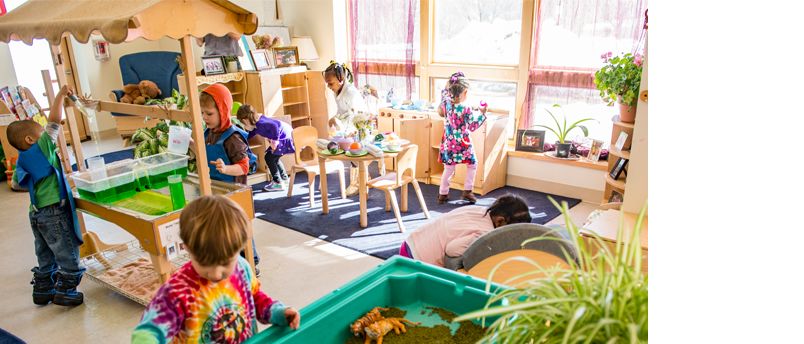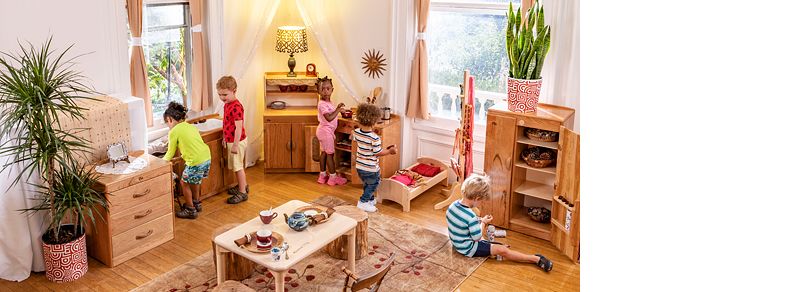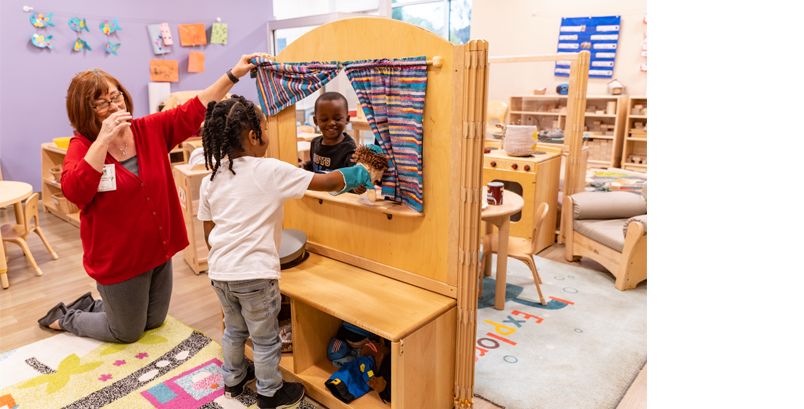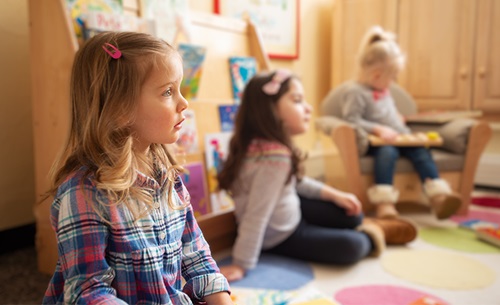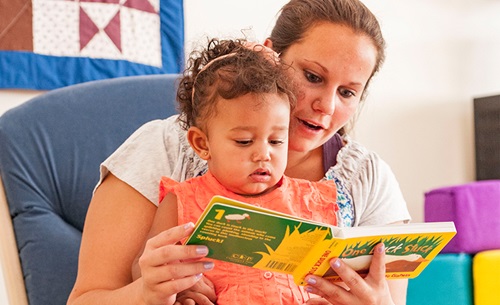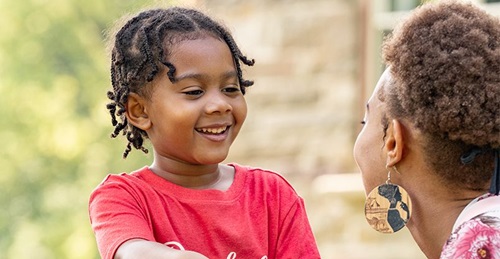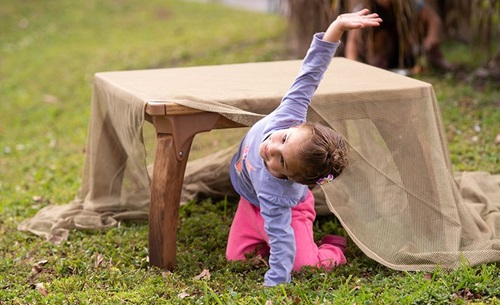Classroom Design and How it Influences Behavior
| September 2006Early childhood classrooms serve as the physical environment for adults and young children for most of their waking hours. Although it is important for classrooms to be attractive to the eye, it is equally, if not more important, that they function effectively.
Your childcare environment influences how you feel about yourself and your job, and how you as an early childhood professional relate to the children in your care. The children in your care experience the environment indirectly though interactions with you, and directly through their own experience with the physical setting.
Play Units and Behavior
The roots of current beliefs about relationships between individuals and early childhood environments lie in the work of Sybil Kritchevsky and Elizabeth Prescott (1969), whose classic analysis of child care settings in the 1960s led to important observations of the influence of classroom design on the behavior of both children and teachers. Based on these observations, Kritchevsky and Prescott show how teachers can alter the environment to achieve new goals or solve existing problems. They also highlight the importance of tailoring the childcare setting to fit the needs and experiences of the children who spend time there.
In their analysis, Kritchevsky and Prescott identify play units, which they assess in relation to complexity, variety and amount to do.
Complexity and variety provide measures of interest and help teachers determine how long children can be expected to play. Complexity relates to a play unit’s potential for manipulation and change by the children. Variety refers to differences in the types of activity that a play unit permits (e.g., climbing, crawling). Amount to do relates to the number of choices that a particular play unit provides for the children.
With respect to complexity, Kritchevsky and Prescott describe three types of play units:
- Simple play units - with one obvious use and without subparts or juxtaposed materials: for example, a swing or tricycle.
- Complex play units with subparts - two different play materials juxtaposed to enable a child to manipulate or improvise: for example, a housekeeping area with supplies. Single play materials that encourage substantial improvisation or have elements of unpredictability are also considered to be complex play units - for instance, a table with books.
- Super play units - a complex unit with one or more additional play materials - for example, a dough table with tools.
Although each type provides particular benefits, a play unit can also be a source of problems. Simple units may not hold the children’s attention for long, leading to difficult behavior and the need for teacher intervention. Complex units may require more time than teachers can provide, causing children to become frustrated and disappointed.
A Well-Organized Space
When space is well-organized, with open pathways that clearly lead to activities that offer enough to do, children manage on their own. They can move freely from one activity to another, giving the teacher an opportunity to attend to individual children according to their needs.
Space that is not well-organized creates problem areas. These include dead spaces that encourage wandering and unruly behavior, and pathways that lead nowhere or interfere with play already in progress.
When space is poorly organized, children depend on the teacher for guidance and the teacher’s behavior becomes directive. When teachers spend a great deal of time directing group behavior, they have less time to assist individual children and children have fewer opportunities to participate in free play.
The setting can be a major barrier to the achievement of teacher goals, including the goals teachers set for the children in their care. When these goals seem out of reach, changes in classroom design may lead to the desired results. For example, after an appropriate change in the environment such as the addition of a complex or super play unit, children may engage in more free play, exhibit greater self-reliance, or develop longer attention spans.
Classroom Design and Learning - Current Research
In the 1990s researchers are continuing to explore in detail how the physical environment influences child development and learning. Their activities relate to the work that you do because they show how you can use classroom design to achieve specific program goals. For example, Alton J. De Long et al. (1994) discovered that by changing children’s sense of space they changed their sense of time. To carry out their experiment, the authors constructed, within a natural classroom, a scale-reduced structure that resembled a child-sized, portable, screened-in porch. They discovered that when children (mean age four years, two months) played in this scale-reduced structure, they entered complex play faster and spent more time in complex play than when they played in the natural classroom. Although the experimental sample was small, these findings suggest that you may be able to increase children’s attention spans and help them process information more quickly by altering the scale of their learning environment.
Similarly, Petrakos and Howe (1996) report that the physical design of equipment and toys influences children’s play. They cite research supporting the idea that the physical arrangement of the play setting can directly influence the types of children’s play, and that the introduction of novel themes and equipment in dramatic play centers stimulates more sophisticated group and dramatic play interactions (for example, Howe et al., 1993.)
To carry out their study, they observed four- and five-year-olds in a “traditional” housekeeping center and in two “extended” centers (super play units) on housekeeping and train station themes designed specifically for the experiment. The traditional housekeeping unit accommodated group play, while the four extended centers, two for each theme, were arranged in solitary (for example, one chair at a table, one seat on the train) and group designs (for example, two or more chairs around a table, two seats on the train).
At the end of their study, the researchers determined that the solitary centers facilitated more solitary play, and the group centers facilitated more group play interactions. They also discovered that the children’s play was more imaginative in the extended units and in a follow-up session in the traditional unit. They concluded that traditional thematic play centers and structured play materials may limit play choices, while less realistic materials are more likely to foster more creative and imaginative play.
For example, they suggest that teachers can encourage more imaginative play by providing “an all-purpose vehicle” like a box with a control panel, rather than a “specifically designated” bus or mail truck. By formulating specific goals (such as to encourage imaginative play), and designing the environment to achieve those goals (providing less realistic materials), teachers influence the content of children’s play and children adopt a wider variety of roles. This research confirms that by reorganizing your early childhood environment, you can influence what happens there.
Ten Steps to More Effective Classroom Design
- Think about your philosophy of education and teacher goals.
- Consider how your philosophy and goals relate to the space that is available and the activities that take place there.
- Assess the children in your care and identify their particular developmental needs. Find out as much as you can about the nature of the space that is familiar to them in other settings and the kind of interactions they are accustomed to.
- If you are working with an existing setting, observe children and staff in that setting. Make notes about what appears to work well and what does not work well there. Look for checklists, like the ones provided by Kritchevsky and Prescott (1969, 49-50), that may help you evaluate what you see.
- Take advantage of as many available resources as possible. Read what you can; become familiar with recommendations for the best possible use of space as well as regulatory requirements; visit other centers; and discuss proposed changes with others, including fellow staff and your builder or architect (if appropriate).
- Make a “paper doll kit” and move the pieces around, keeping in mind what you have learned, the goals you have set for yourself, and what you expect to happen there. Write down your thoughts about how your classroom should be designed and the effects your changes should have.
- Reorganize your room and change your teacher behavior accordingly.
- Observe the effects of the changes you have made and decide whether your goals have been achieved.
- Make further changes based on your observations.
- Begin the cycle again by considering whether your educational philosophy and goals are still appropriate in view of your current situation.
Conclusion
There is definitely more to classroom design than meets the eye. A pleasing appearance is of secondary importance to how a design functions in a given situation. Since the 1960’s, researchers have identified links between the physical environment and the behavior of both children and teachers. In the 1990’s, research continued into how changes in the environment influence child development and what is learned in classroom settings. When observations of what happens in a particular environment are combined with knowledge of educational philosophy, the physical environment takes its place with other program elements as a full participant in early childhood curriculum. Although some alterations are more permanent than others, classroom design is ultimately a tool whose flexibility can be enhanced through planning and modeling before actual change occurs.
Reprinted with Permission --Early Childhood NEWS

